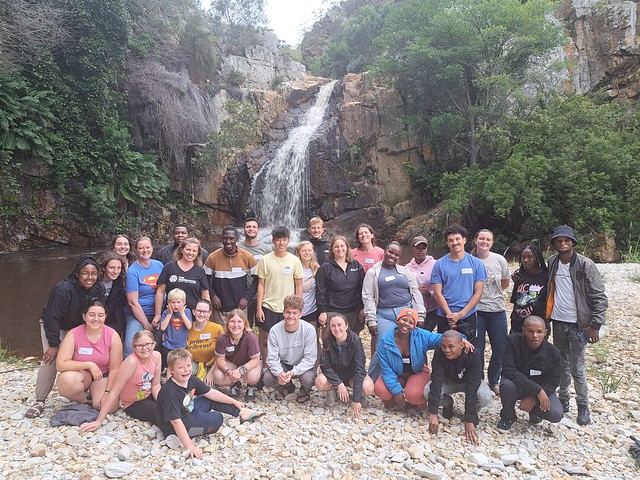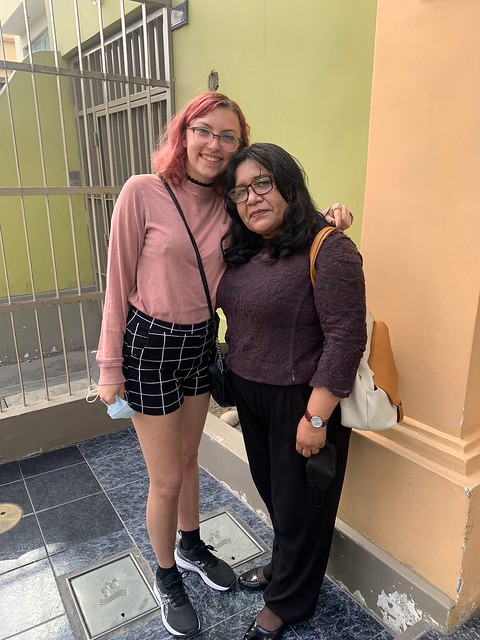This past week we spent our time in Hermanus, with homestays in the neighboring township Zwelilhe. We were split up among 8 host families, where we spent our evenings and early mornings. We spent the majority of our weekdays at Volmoed – an intentional community and retreat center. During that time, we took part in a contextual Bible study alongside youth from Zwelilhe who were involved in the Volmoed Youth Program, a program that cultivates youth leadership. The contextual Bible study focused on the Triumphant Entry passage found in Matthew 21. We explored themes of violence and peacebuilding through historical study, scripture re-enactment, and group discussion. We navigated how to apply these themes in our current contexts, both in South Africa and the United States.
An Ode To A Contextual Bible Study
By Molly Piwonka
Journeying towards new understanding
Collectively working to disassemble peace and violence
Cloudy concepts
Concepts of complexity
Questions arise
Is one black and the other white?
No
This dissection leaves not two, but many tiny fragments
Can one exist without the other?
Not within human understanding, but maybe beyond those limits
Did the Prince of Peace cause disruption?
Tables turned over
An act of violence?
Ideas turned on their heads
An upside-down kingdom
Human acts might need disruption
Society might need shaken
If you’re to “be woke” don’t fall into passivity’s sleepy spell
Is peace inherently good; while the other bad?
Try again
Is violence inherently bad; while the other good?
Try again
Don’t you see?
These are difficult distinctions
They depend on perception
Good; bad
All is relative
Don’t lose hope
This all takes time
Do feed on this feast of ideas
Do quench your thirst on this stream of thoughts
In time points might be woven together
Or more questions might be produced
Either way this journey is filled with much interest and support
Don’t be discouraged
Other activities this week included a drum circle where we were taught the basics of Djembe drumming by an animated veteran of the instrument named Bevel. He employed various teaching strategies including having us drum on our neighbors, scream as loud as possible, and showing u s the basics of how to visually identify a good drum.
s the basics of how to visually identify a good drum.
Later we were also
graced with a chance to meet John DeGrutchy, prominent South African theologian, and author of two of the books our group had been reading. Our conversation felt brief but included such weighty themes as the relationship between faith and politics, who God is, and who humans are in relationship to him. 
On Friday, we took a road trip to Cape Agulhas, the southernmost tip of Africa. We played in the waters where the Atlantic and Indian oceans meet. A place of natural beauty, we were awed by jellyfish, snails, sea-urchins, crabs, rocks, and sting rays. The rest of the weekend was spent soaking up our final moments with our host families. Some of the EMU students were able to experience a traditional Xhosa umgidi ceremony, where the community celebrates the homecoming of young men from the bush. Virtually every Xhosa boy will travel to an initiation camp and undergo various challenges in order to earn their manhood. Umgidi attracts the entire community and includes lots of dancing, eating, and drinking. Other Saturday plans included walks along the harbor and a classic braai. After church on Sunday, we said our goodbyes to our dear friends and families from Zwelilhe. From Hermanus, we rode the bus to Jeffrey’s Bay where we had plans for rest, rejuvenation, and a debrief surrounding the events of our intercultural semester so far.

































